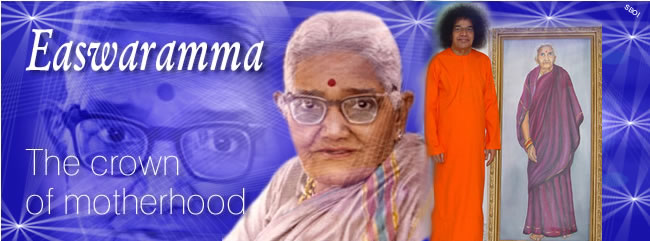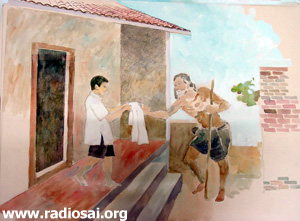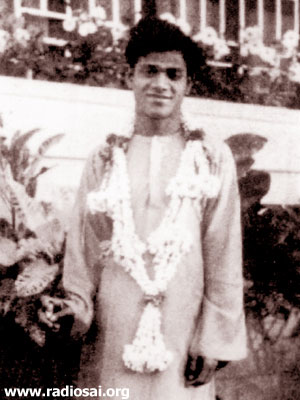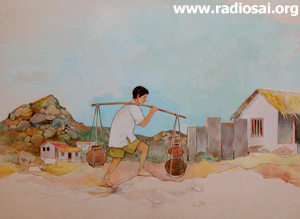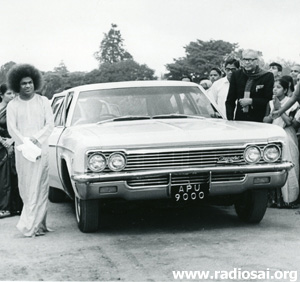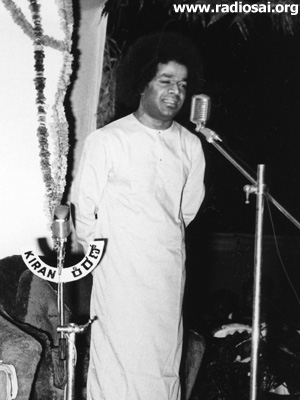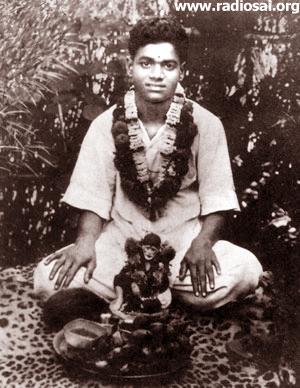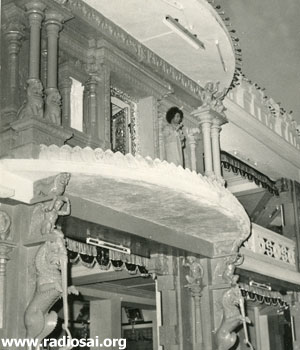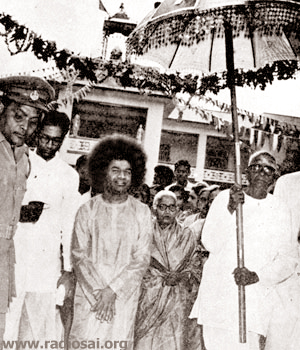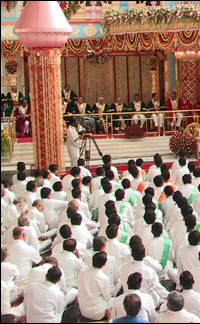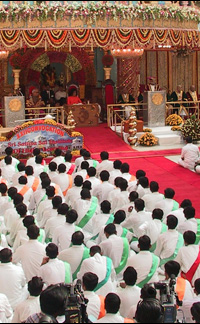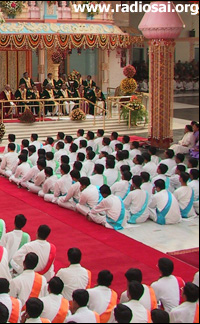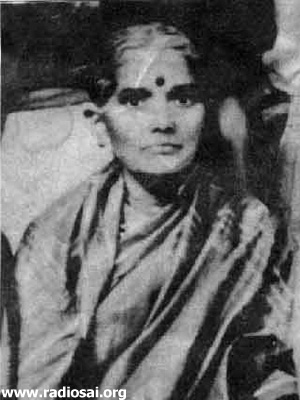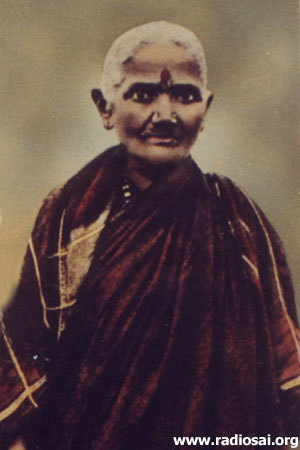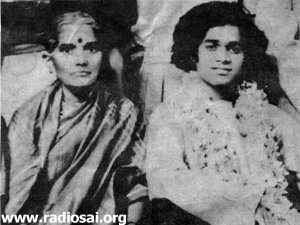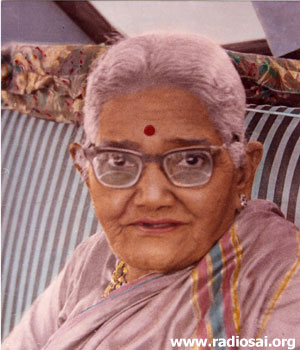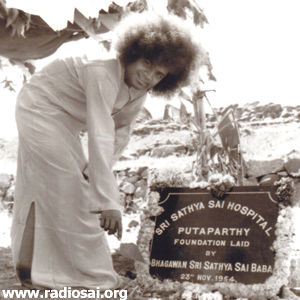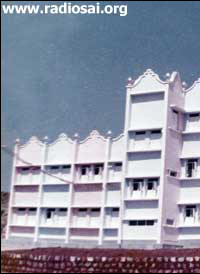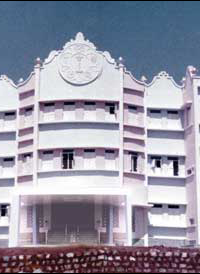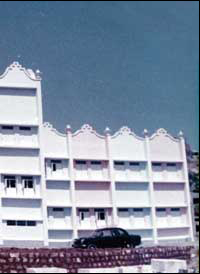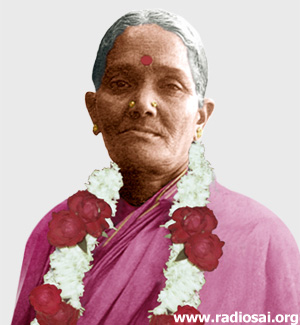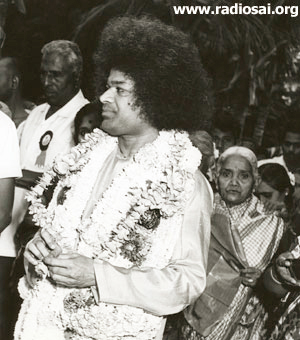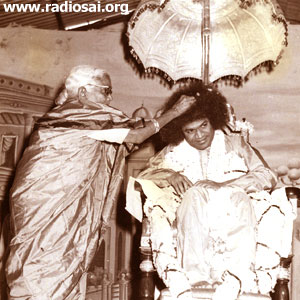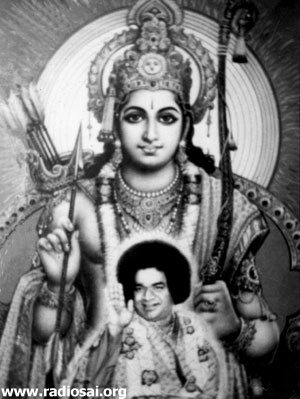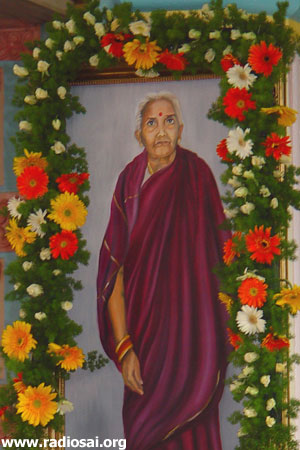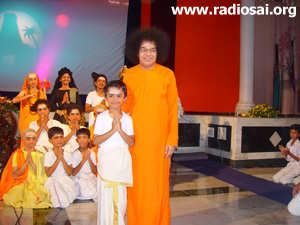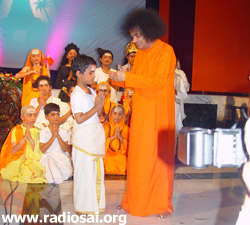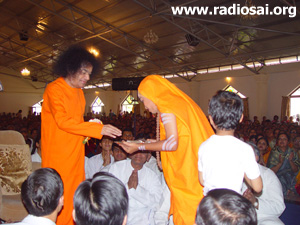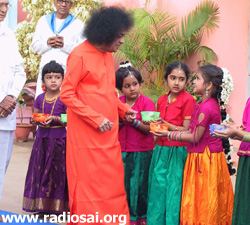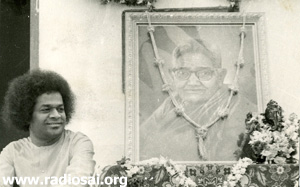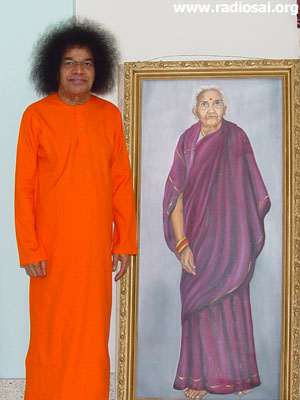|
Home |
SBOI-Group|
Pictures
|
Audio-Video |
Wallpapers|
Greeting-cards
|
Ashrams Info.
Sai news
"Easwaramma was the chosen one. I chose her
to be My mother. That is the intimate relationship between Mother Easwaramma
and Myself."
|
That was the
emphatic declaration of Bhagavan on the most auspicious Easwaramma Day, the
6th of May, 2001. In no uncertain terms Swami communicated how lofty, grand
and glorious is the stature of Mother Easwaramma. The thronging crowd in Sai
Ramesh Hall exploded into loud applause that evening as they heard these
Divine words from Bhagavan.
Easwaramma - Mother Divine
Mother
Easwaramma, truly, was a divine effulgence which graced mother Earth with a
sacred mission and purpose by the inscrutable will of the Divine just like
Kaushalya, (Mother of Sri Rama), Devaki (Mother of Sri Krishna) or Mary
(Christ’s Mother). She underwent similar agonies and ecstasies, fears and
dilemmas, trials and triumphs, and ultimately bliss and beatitude that the
Divine Mothers of yore passed through.
Like Krishna,
Swami was the eighth child of Mother Easwaramma and the turbulent times she
went through before he took birth were akin to what Devaki experienced
before Krishna graced her lap. None of Mother Devaki’s previous seven
children could escape from the heinous designs of the demon Kamsa.
Easwaramma too suffered at the hands of cruel fate. She had four
miscarriages in a row before the Light of the World descended as her Son. |
|
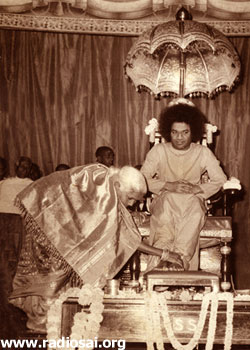 |
|
The Mother performs Padapuja to
The Lord |
|
"Easwaramma" – The Name Said It All
It was not as if
it was totally unannounced, for Kondama Raju, father-in-law of Easwaramma, had
dreams of the family preceptor Venka Avadhootha instructing him to be prepared,
though for what he was not told. As Swami explained:
Kondama Raju, the grandfather of this physical body, being a jnani (one of
wisdom), was blessed with a vision of the future. One day he called his son,
Pedda Venkama Raju, and told him to change his wife’s name to Easwaramma. He
told this because he felt the divine vibrations originating from within. His
intention was to convey that she was the mother of Easwara, God Himself. But
Pedda Venkama Raju was not aware of the inner meaning of this name. He
implicitly obeyed the command of his father and changed the name of his wife
to Easwaramma. Easwaramma was first christened as Namagiriamma at the time of
birth.
So long before
Swami was born, Namagiriamma became Easwaramma, meaning the Mother of Easwara,
or God, and in his own inimitable way the Divine Lord announced his coming
advent.
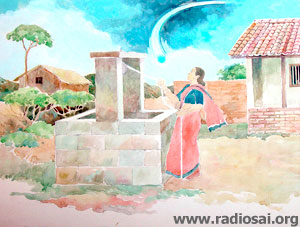 |
|
The precursor to the Divine Descent
|
|
|
Many years
later, a Pundit well versed in the Puranas asked Swami, “Was your
Incarnation a Pravesa (an Entrance) or a Prasava (Enceinte)?”
Turning to
Easwaramma seated in front, he said, “Tell what happened that day near the
well after your mother-in-law had warned you.”
The Mother
said:
She had dreamt of Sathyanarayana Deva and she cautioned me that I
should not be frightened if something happens to me through the will of
God. That morning when I was at the well drawing water, a big ball of blue
light came rolling towards me and I fainted and fell. I felt it glide into
me.
“There you have the answer!” Swami said, “I
was not begotten. It was Pravesa, not Prasava.” |
|
The First Miracle
So it was the
Divine had decided to descend and had chosen the womb of Mother Easwaramma
as his temporary abode. When the sacred moment arrived in the early hours of
the morning on that holy Monday, the day dedicated to Lord Shiva, on the
23rd of November 1926, the Chosen Mother had just consumed prasad
(consecrated food) given to her by her mother-in-law after the hour-long
Sathyanarayana Puja.
She accepted
and relished the sanctified food and before the sun had spread its morning
light on the Rathnakaram home the house was bright with jubilation, joy and
gaiety – the long awaited son was born. Those present were blessed to
witness the first miracle of the Divine Personality, described by Prof. N.
Kasturi, Baba’s biographer:
A mat covered with a thick bedspread had been placed in a corner
of the room, when the labor had begun, and now the baby was placed on it
by the grandmother. Suddenly they found the bedspread rising up and
falling down on either side of the baby. She grasped the child and held it
close. A serpent was coiled beneath! Of course, snakes there were in
plenty at Puttaparthi, creeping through crevices, crawling along the
walls, and hiding in holes. But a serpent in the lying-in room pretending
to be a bed – it was the role of Adisesha for the Vishnu who rested on its
coils. This was the Incarnation’s first miracle. When Easwaramma was asked
about this epic event, she confessed she had been so filled with joy at
the birth of a son she had never even noticed the agitation all around.
|
|
|
|
|
Seshashailavasa Narayana...
|
|
Sathya’s Attitude Baffles Easwaramma
Yes, the
“Rathnakaram” family, meaning “a treasure chest of gems,” now had its most
precious jewel and the home was a hive of activity. With his bewitching looks
and captivating smiles, little Sathya (Swami’s childhood name) instantly become
the cynosure of the village. Later, his prodigious talents in music, dance and
poetry, and his divine leelas enacted right from early childhood on
would bring joy to many. As for Easwaramma, she was the one who fretted over
Swami every moment and suffered the most from his indifferent-to-this-world
attitude. In her own words:
|
|
|
"I Do Not Need Anything" - Sathya
|
|
|
He [Sathya] never asked for any
particular food or clothes. A bundle of clothes would be brought from
Hindupur or Anantapur and one of the grownups, father or grandfather,
would call the boys in the family asking each one to choose for himself.
But Sathya always sat aloof until the others had made their choice and
then he would take whatever was left behind, rejected by the others. He
never seemed to have any desire or wish of his own, but his face would
light up with a beam when he saw the other children happy. When we asked
him what he wanted, a smile was the only reply. I would hug him close and
try to get him to confide his wish to me.
‘Sathya, tell me what you want. I will
give it to you,’ I would say. ‘I do not need anything’ was his only
answer. ‘Whatever you give me, I will accept. That is enough for me. I
will not choose.’
|
Sathya used to
play with other children and sing bhajans for hours on end. Her daughters
reported that he performed a very intricate dance a child artiste demonstrated
during a drama in Bukkapatnam even better than the original. But Sathya’s
solemnity inside the house disturbed his mother beyond measure. Years later
Easwaramma would recount:
This was something I could not understand. How were we different? What made
him so deeply sober and serious? I began at last to wonder whether the label
Brahmajnan [a realized soul] the village elders had stuck on him and which I
had thought a mockery was indeed a tribute after all.
Then Yashoda, Now Easwaramma
Like Yashoda, Sri
Krishna’s foster Mother, Easwaramma would often pray for Divine intervention for
Sathya to turn into a normal Puttaparthi boy. Still, Easwaramma could see in him
the potentials of a poet, a singer, a dancer, a playwright and a director and
she hoped he would blossom in these fields. In fact, such were Sathya’s
theatrical skills and such was Easwaramma’s simplicity that whenever she saw him
being “tortured” in a drama he acted in, she wept aloud and even tried to
protect her Sathya!
And again like
Mother Yashoda, who was troubled and torn by instances of demons vying for the
life of her sweet darling child, Mother Easwaramma too faced agonizing and
abnormal experiences. After every display of Sathya’s supernatural powers her
worries only increased. Here is what she experienced told in Swami’s own words:
When
Swami was staying in the Old Mandir, one day there was an unusual crowd.
Sensing danger, Easwaramma came to Me and said, ‘Swami, these people seem to
be having some ulterior motive. I am afraid they may try to harm You. I am
unable to sleep peacefully.’ I infused courage in her, saying, ‘Be fearless.
The body is bound to perish one day or the other. So, give up body
attachment.’
Those days I used to sleep all alone in a
thatched hut. That night, as Easwaramma feared, some evil-minded people
set the hut on fire from all four sides. There were raging flames all
around. Seeing this, Subbamma and Easwaramma came running. When they
reached the spot, they found to their utter amazement there was a heavy
downpour on the hut. However, there was absolutely no rain in the
surrounding area. When I came out of the hut, both of them were overjoyed
to see Me safe and sound.
Similarly, on
another occasion Swami shared:
One day, somebody invited Me to their house for food. Actually their
intention was to poison Me. They were feeling jealous of My growing
popularity and prosperity. In those days I used to relish vadas made of
Alasanda grains. Hence, they mixed poison in vadas and offered them to Me.
Before going there, I had told Easwaramma and Subbamma not to be afraid if
any untoward incident was to happen. When I returned from there, My entire
body turned blue and My mouth started frothing. I told Easwaramma to wave
her hand in a circle. She did accordingly, and to her utter amazement
there appeared vibhuti in her hand. She mixed it in water and gave it to
Me. Instantly, I became normal. She wondered, ‘Swami can create vibhuti
with a wave of his hand. But how is it that vibhuti appeared in My hand?’
In fact, I had given her that power for that moment.
|
|
|
|
|
Easwaramma's darling Sathya
|
|
Easwaramma went
through many trying times mothering the “infinite power” incarnated in her
humble home, though of course there were also mystical and profound experiences.
When Sathya was just nine months old, one singular episode baffled her beyond
her limits.
I can
remember the whole incident fresh and clear. I had just bathed and dressed him
and applied on his eyes cooling collyrium. I applied vibhuthi from the Shiva
temple and a dot of kumkum from the Sathyamma temple on his brow. I put him in
the cradle, gave it a swing and turned to the hearth where the milk had come to
a boil. Suddenly I heard him cry. I was surprised for, believe me, he had never
cried since birth for any reason, hunger, or pain, or discomfort. I picked him
up and placed him on my lap and he stopped the wail. I saw a halo of brilliant
light all around him, a circle of radiance surrounding him. But the light did
not hurt me, it was so cool though so bright and near. I sat still, lost in
delight. It was there a long time, before it faded slowly away. I closed my eyes
and probably lost awareness of everything around until my mother-in-law came to
me and I awoke. The child was apparently asleep. She asked me what had happened
and I told her about the halo that I could see even then in clear outline. She
put her finger on her lips and said, ‘Don’t tell anyone of this. They wouldn’t
understand. They would spread all kinds of tales.’
Easwaramma would
be blessed with countless such experiences and every one increased her love for
the beloved son she had been gifted with after so much prayer and penitence.
The Mother’s Heart Bleeds…
Sathya was so
bright that denying him further education seemed a sacrilege, so as there was no
high school within a radius of twenty miles he went to live with his brother so
he could attend school at Uravakonda. Easwaramma had to sigh and cry alone, and
it must be added, now and then to exult and enthuse, for stories seeped through
the intervening miles of the marvels Sathya had authored, the cures he had
effected, the problems he had solved, as well as of the hardships he had to
undergo.
|
|
|
Love without duty is Divine
|
|
|
During a visit
to Puttaparthi from Uravakonda, Easwaramma gave Sathya an invigorating “oil
bath” and observed on his left shoulder a broad length of blackened
thickened skin. Sathya did not complain of pain when the patch was touched
or pressed and laughed it off when she asked how he had acquired that mark.
But when Easwaramma insisted, he told her that the skin was rendered so as
the result of carrying water pots hung on both ends of a pole borne on his
shoulder for the household where he stayed. There was only one well at
Uravakonda for drinking water which was nearly a kilometer away, so he
walked to and fro about six times daily, thrice in the morning and thrice in
the evening.
Easwaramma was
alarmed. “You must come away from there. They
are exploiting your goodness and your desire to serve. Why should they
depend on you for water?” But Sathya responded, “I felt it as my duty, Amma. How long can the
children survive on the brackish poison? I carry the water of life from that
distance gladly, Mother. I have come to do this service.” Mother was
in tears and could hardly speak. Immediately, Sathya was back home in
Puttaparthi. |
The Mother’s Greatest Anxiety – Swami’s Food Habits
If Swami was away
from her for some time and a visitor came from that place, Easwaramma would
invariably ask, “How is Swami? Is he keeping
well? Does he eat anything at all?”
Swami’s eating
habits were always a subject of concern for the Mother. Every now and then
Easwaramma would go into the Mandir, for there were no regular hours for her or
anyone else, and she would note the new arrivals, talk to them and then move
quietly towards the women who were mothering her son.
“Serve him and nurse him with care,” she would
plead. “Look at him; one can count the ribs, they are coming through so clear.
He won’t listen to what we say. He insists on his own ways, all the while
telling us how to behave. And somehow he justifies everything he does as good
for himself.”
|
Noon and
night, lunchtime and dinnertime, whenever she thought about it
Easwaramma was confronted by a conundrum. How could the Ananda of others be
Ahara [food] for him? He ate so meagerly. He relished so
little. He set aside so much. He had no obvious preference, no visible
appetite, no taste to satisfy, no hunger to appease, and no time to spare.
How could he derive sustenance from this Anandaless atmosphere? She prayed
for him to eat but it was all in vain. Swami would take a mouthful just to
satisfy her and then stand and walk away.
It took
Easwaramma a long time to reconcile herself to this Avataric trait. Whenever
she was around she personally supervised the preparation of the menu for
Swami by going into the host’s kitchen. She believed that Swami would eat a
few more spoonfuls if the cuisine was Telugu, or better still, if it was
genuine Rayalaseema, the region to which Puttaparthi belonged. When
Swami was at Jamnagar with the Rajmatha of Nawanagar (in Gujarat),
Easwaramma feared that the Gujarati dishes might not be acceptable to her
son. She smuggled herself into the palace kitchen and sought permission to
prepare a little chaar – a soup based on boiled pulses – so Swami would have
some food of familiar taste.
This mother’s
concern never left her alone. Her eyes were on his plate to discover how
much he tasted of what and how his health reacted to the restraints he
imposed on himself. When Bhagavan was forty-four-years-old, Easwaramma was
heard to say, “He does not like their
cooking. He used to eat well as a boy when I cooked his food. But he does
not care for my cooking now. He says I must have rest and quiet and not to
worry about such things.” |
|
|
|
|
....so that we may learn to serve
|
|
When Swami was a
child, Easwaramma would have to spend an hour to persuade him to swallow a
mouthful. The thinnest of excuses – a crow cawing for a morsel, a mendicant
voice from afar, a child crying next door – sufficed for him to run away from
the plate before him.
On one occasion
Swami took to drinking only a cup of buttermilk per day…for thirty-six days! One
can imagine the heart-rending pain Easwaramma went through, struggling to hold
back tears which threatened to well up throughout the day. When at last Swami
said in response to the devotees’ prayers he would resume his normal schedule of
breakfast, lunch, and dinner, Easwaramma was happy beyond words and asked him to
never tease them with such tactics again. Even years later, whenever she
recalled those thirty-six days, it was with a sigh and expression of
resignation.
Her Childlike Simplicity
Mother’s concern
for Swami extended to every detail of his life. Apart from his spartan food
habits, another subject which troubled her was Swami’s travels. She was
always apprehensive of him leaving Puttaparthi even if it was for only a day to
a nearby city or town. So imagine her distress when she heard about the planned
trip to East Africa in 1968. She was extremely nervous, to say the least.
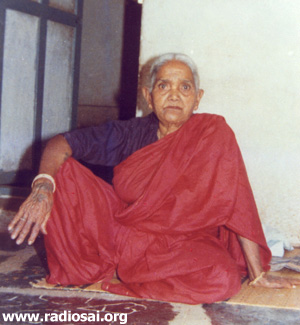 |
|
Simplicity personified
|
|
|
Not much was
known about Africa in those days, and the popular impression was that it was
a dark continent full of wild animals, savages, and cannibals. Easwaramma
had heard this folklore and feared Swami would be in danger if he went
there. She resolved to have the trip cancelled and expressed her
reservations to someone involved with the expedition. The person replied,
“Mother, do not worry. Swami will be visiting only big cities where he will
be absolutely safe – no threats from animals or savages there!”
Easwaramma was
dissatisfied with the reply and felt hurt that the person was making light
of a serious matter. She approached someone else and told him, “Listen, all
of you are merrily planning a jaunt to Africa without being conscious of the
risk to Swami. It is not too late yet, and you must do everything possible
to dissuade him from undertaking this trip.” The person she spoke to gave a
patient hearing and then replied, “Amma, have no fear. Swami will have very
high security protection.”
Easwaramma
felt frustrated that no one was taking her misgivings seriously. She sought
out a senior devotee and conveyed her worst fears to him. This devotee said,
“Mother, it is true that there are many dangers in Africa. But how can they
affect Swami? He is God, is he not?” Hearing this Mother Easwaramma became
furious and shouted back, “You fool! I know
Swami is God and you know he is God. But do those savages and wild animals
in Africa know he is God?” |
That was the
Mother’s childlike concern and simplicity. Though she had realised her son’s
divinity, motherly anxieties often overwhelmed her. Sri Jayalakshmi Gopinath,
who was fortunate to interact with the Mother and observe her at close quarters,
recalls:
I
knew the Divine Mother Easwaramma so well. It was mutual love between us. I
loved her because on her face there was such brilliance that you could not
find anywhere in the whole world on any sophisticated face. Whatever one would
put on the face it could not match the glow on her face. I have seen it
myself. She was as simple as a child.
Easwaramma Travels With Swami
Ask any of those
old timers who knew the Mother and they will say, “She was so humble, so
lovable, so simple.” Swami, who was filled with compassion at Easwaramma’s
rustic upbringing, believed that travel was the surest way to broaden her views.
Swami persuaded her to come with him and the devotees to Bangalore. Fast cars
sped them along macadamized highways, through stretches of brown barrenness, and
then carpets of cool green, jowar, paddy and ragi, sweet sugarcane and cotton.
At Madras she saw the sea for the first time. Swami had described the ocean to
her in epic terms, for these were the waters that Rama and his monkey hordes had
crossed in the Tretha Yuga on their way to Lanka. A few drops sprinkled on the
head purifies a person to perfection, he said, for into it flows the holy rivers
Ganga, Jumna, Kaveri and Godavari.
Easwaramma
was touched to the depths of her being as she gazed in awe at her first vision
of the ocean, boundless in its immensity, eternal in its rhythm of surge and
swell, forever changing yet ever the same, an endless expanse with the horizon
as its limits, the sky as its roof, and the subtle colors of space – blue, deep
gray-green, cloudy-white. She burst into an exclamation of wonder that this was
the very Mirror of God reflecting the majesty of his many moods.
|
For the first
time Easwaramma knew the hurry and scurry of cities, the noise of bazaars.
She greeted lions and tigers, pythons and peacocks, and those most strange
creatures, the giraffe and the kangaroo, at the Mysore Zoo.
She enjoyed
the cool comfort of Bangalore and weathered the biting cold of Ootacamund on
the Nilgiris and the Blue Mountains of Tamil Nadu. She visited the fabled
temples and sacred rivers of India, while Swami showered his constant
attention upon her. This was his special grace, she knew, for she had not
yet completely severed her maternal attachments and soared into the blissful
freedom of supreme trust and devotion.
Easwaramma
would often be a part of the troupe accompanying Baba to remote spots in
Andhra Pradesh and other parts of India and would ride in the car following
Bhagavan’s.
During
the summer months these excursions could become unbearably hot and Swami
would ask her to relax in his car to be cooled in the air conditioning but
she always politely declined the offer. Easwaramma never hankered for
physical comfort and was satisfied with the way things were. |
|
|
|
|
Sai travels the length and breadth of
India
|
|
When Swami and his
devotees left Lucknow for Benares, the Secretary to the Governor drew up the
order of precedence according to protocol for the entourage of cars: the pilot
car with Swami and the Governor, the Police car, the Rolls Royce with the
parents, the Secretary’s car, the car with the Editor of the Sanathana Sarathi,
and so on. Easwaramma, however, preferred to ride in the van with her sister
devotees whom she could regale with her colorful anecdotes to the lonely luxury
of the Rolls Royce.
Her Innermost Fears
|
|
|
The treasure chest of all wisdom
|
|
|
In 1956, a
sanyasi and learned scholar, Swami Amrithananda, came from
Thiruvanamallai for Swami’s Darshan. He had lived with the great master
Ramana Maharshi for a long time and Swami invited him to stay for several
months in Puttaparthi. As it was Dasara, Swami was blessing the devotees
with discourses every day. During one such discourse, Easwaramma asked Swami
Amrithananda in Telugu, “Ememo cheputhu
unnade, sariga cheputhada?” meaning, “He is telling so many things. Are they
all correct?” That was the motherly concern of Easwaramma for Swami.
Though she had seen many instances of Swami doing the impossible, yet her
heart was always anxious and her lips silently praying for her son’s
welfare.
Then there
were the village rumors: “This is not going to last long,” “Sai Baba’s
powers will soon be drained away,” etc. Whenever such gossip assailed her
ears she would pull out from the private treasure trove of her memory
remembrances of the incredible events she had witnessed bearing testimony to
the authenticity of the Avathar that was now before her. On that occasion
when Swami Amrithananda replied, “Amma, he is Parabramha. He knows
everything. He is my Guru and God,” it was yet further confirmation to her
of Baba’s divinity.
When
Swami made plans to visit the holy sites of the Himalayas, Easwaramma became
alarmed that her son might fall victim to black magic motivated by religious
rivalry from the yogis and monks of that area. She confided her
reservations to Professor Kasturi and he calmed them by promising to recite
the Gayatri mantra and invoke its protective powers. |
“Easwaramma Was Like Yashoda” – Baba
These accounts
remind one of Mother Yashoda, who likewise often looked upon Krishna as her son
and found herself forgetful of his true status. Perhaps God had willed it so,
otherwise how could she have experienced the bliss of mothering the master of
all creation? Comparing her to Yashoda, on Easwaramma Day 2001, Swami said:
...The following week, I went to see Kondama Raju again after visiting
Subbamma's house. He came to know that I was coming to his house. Immediately
he called Easwaramma and told her, ‘I am not going to live any longer. Having
known that my end has approached, God is coming to shower his grace on me.’
She responded in an innocent way saying, ‘Where is God? How do you know that
he is coming?’
Then
Kondama Raju said, ‘O mad woman, still you are deluded by the feeling of a
mother toward her son! Look there, God is coming.’ So saying, he pointed at Me
as I was entering his house. She too was aware of My Divinity but she used to
get carried away by her motherly affection toward Me. Similar was the case
with Yashoda. Though she had seen all the fourteen worlds in Krishna's mouth,
she thought it was a dream or an illusion.
The
Mother’s Distress As Sathya Becomes Sai Baba
Yes, there were
many occasions when she vacillated between being a mother and devotee. The
transition from doting mother to adoring devotee was a long and tortuous path as
her son was revealed as the Source of divine light shining his benediction on
humanity. Just picture this scene as the anxious parents had rushed to
Uravakonda to visit Swami, who was then still a mere lad. They were confronted
with a large crowd of devotees who cheered them as, “Matha Pitha ki jai,”
(Victory to the Parents!) close on the heels of each full-throated “Sai Baba ki
jai” (Victory to Sai!). Sathya was seated on a chair with flower garlands piling
up on his right as he accepted each one that was offered and added it to the
mound. But when pressed to identify his parents, Sathya said concisely, “They
are Maya” [illusion].
|
“Maya!”
exclaimed Easwaramma, and fell in a faint. When she came back to her senses
she sat by Sathya’s side, tears coursing down her face, for her son was but
a shadow of his former self though only three months had elapsed since she
last saw him. “Sathya, speak to your mother!” she begged. A few minutes of
silence ensued.
Then, “Who
belongs to whom?” asked Sathya, remote and cold. It was not a question but a
pronouncement. Baba continued with her lesson. “It is all Maya, it is all
Maya.”
Her only
consolation was when Sathya agreed to eat some lunch. She finished serving
and nervously signaled that her offerings be accepted. With a swift movement
Sathya swept all the food into one mass and rolled it into three balls.
“Maya! Maya!” he kept repeating.
Someone told
the stupefied mother that Sathya was bidding her come near and she moved a
few feet forward. He put one of the balls of food in her right palm and kept
his palm before her to receive it. As she gave it back, Sathya ate,
whispering, “Maya is gone, Maya has left.”
This scene is
unique in the annals of human experience, for who can fathom what Easwaramma
must have felt in her heart – nothing could have prepared her for the jolt
as her little Sathya became Sai Baba, Guru to the whole world. She alone
bore the brunt of this metamorphosis of her dearest Sathya to a discreet and
distant Sai Baba. |
|
|
|
|
“Maya is
gone, Maya has left” - Sathya
|
|
Prashanthi Nilayam Is Born But The Mother Is Worried
As the years went
by Easwaramma had to adjust to many other changes that followed the ever-growing
glory of her son. She strained to retain whatever contact she could as Swami’s
time became taken up by the needs of the devotees.
In fact, she was
the one most aggrieved at what she considered Swami’s determination to keep
Puttaparthi at arm’s length. The existing Mandir was already at the fringe of
the village and the new site was a half kilometer further away. Gathering all
the arguments she could drum up against the project, Easwaramma went rushing
into the hall where Baba sat among a group of devotees from Kuppam and cried
out:
"Swami, what is this I hear? They say you are going to build a new Mandir on
that hill. How can you go to a spot that is so far from the village, a place
that is surrounded by jungle and filled with snakes and scorpions? How will
people who are old and sick and mothers with tiny children get to you? Aren’t
you going to bother hereafter with their troubles? Are you going to deny them
your Darshan? What of the fate of those who come to you in the future? You
have the mark of the wheel [the chakra] under your foot and you will never
stay in one place!" she went on agitatedly, "You must always be climbing a
hill or crossing a river to find a place to sit singing bhajans. Which
godforsaken place have you found now? Don’t you know that you must consult
astrologers before you think of moving anywhere? And, listen to me," she
warned, "this Mandir is enough for you. It is better to have a small place
that is filled with people than a huge building half empty!"
There was no interruption to this torrent of
protest. Swami sat in patient silence letting her have her say and merely
smiled at the end of it all. "Speak to me! Tell me something in reply!" she
exclaimed at last in vexation.
Swami softened. “Why do you bother with
people’s talk?” he gently asked and assured her, “There will be no jungle and
no snakes when I go there. There will be hundreds of pilgrims pouring in every
day – and that place will become a Shirdi, a Tirupati, and a Kasi.”
|
Stumped by
this ringing pronouncement, Easwaramma fell back on her eldest son as her
Court of Last Resort. Swami must be persuaded to contain himself within the
Puttaparthi Mandir, she pleaded. Seshama Raju wrote to Swami voicing their
protests, but the letter he received in reply rendered them even more
breathless. Such immeasurable audacity from a mere sixteen-year-old! He was
not to be considered a “son” any longer, Sathya wrote. It was the result of
his own will that he had come as man among men in order to liberate all,
both the good and the bad from misery. He went on to claim that millions
from the four quarters of the world will come seeking him and soon those
standing at the far edge of the crowd would consider themselves lucky if
they could but get Darshan of an orange speck in the distance.
“Millions will come? Here? Where would
they stay or stand?”
Easwaramma wondered as she sent up frantic supplications to the gods to
solve this conundrum of strange events that threatened to overwhelm them
all. |
|
|
|
|
The Prasanthi Mandir in the 1950s
|
|
Though she
witnessed Swami’s miracles in the company of others, her response was typically
more anxiety rather than awe. She calculated that one miracle would lead to
another, for those attracted would clamor for it again and again. She feared
that every miracle would drain Swami’s spiritual power. A few townsfolk
had whispered in her ear that his power would not last long for he was using it
up at a fast pace. She had dared to warn Swami once or twice about this prospect
but had received in reply only a loud, “Bah! I must make everyone happy. I have
come for this, to lead the poor and the miserable into Ananda. Their Ananda
[bliss] is the food that sustains me."
|
|
|
Still,
Easwaramma was apprehensive of the growing number of devotees and losing her
Sathya. On the eve of His ceremonial move to the new Prashanthi Mandir in
1950, she seized the opportunity and secured a boon from Swami that he would
have his dining room on the east side of the upper floor even though he had
chosen the rooms at the other end in which to live.
Swami was very
strict in enforcing the rule that men and women must keep apart, so while
the men used the staircase at the west end, Easwaramma and her daughters
climbed up the one at the east side and spoke to him there. They were no
longer allowed free entry into his apartment.
They would be
waiting and waiting anxiously in the dining room and only when they were
almost desperate would he come, sauntering along the veranda. He came to
give Darshan and not really to eat. Sitting at the small table he would
finger one or two of the carefully prepared and nervously offered items,
utter a few replies to their questions and rise, humming a tune, to return
to the quarters now inaccessible to them. Swami, like Shirdi Baba, allowed
devotees to place offerings on the table, but the hope that he would eat
something from these was a vain one on most days.
The easy
familiar days at the old Mandir were gone forever. But Swami, in his
compassion, granted Easwaramma a few minutes of access to him whenever she
needed the healing touch of his vibhuthi or relief from routine. |
Easwaramma, like
many of her sisters and brothers, was pestered by follies and fears when worldly
desires clashed in conflict. Swami guided her into the realm of
happiness, goodness, and wisdom. He raised her whom he had chosen as the Mother
to the status of his foremost pupil and led her from perplexity to preeminent
faith in the Divinity that deludes us as diversity yet stands ready to help
pierce the veil of Maya and realize the Eternal Truth behind the game of life he
so enjoys playing.
|
The Lord Resides In Puttaparthi…Thanks To The Mother
There was
another boon the Mother secured from Lord Sai that literally shaped the
mission of Sai and made Puttaparthi what it is today. Four years ago Swami
recounted this incident during the Dasara celebrations. He said:
Maharani of Mysore, coffee planter Sakamma, and Desaraj Arasu, the
maternal uncle of Mysore Maharaja, were among those who used to come here
[in the 1940s]. One day they prayed, "It is difficult for us to come here
often. Hence, please come and settle in Mysore. We shall build a big
mansion for You."I told, "I don’t want palatial buildings. I want to be
here."
That night, Mother Easwaramma came to Me with tears in her eyes and said,
"Swami, people want to take You here and there for their selfish purposes.
If you leave Puttaparthi I will give up my life. Please promise me that
You will remain in Puttaparthi forever." I gave her My word that I would
never leave Puttaparthi. This is why I have constructed many buildings in
the Ashram for the comfort and convenience of devotees.
|
|
|
|
| "You will remain
in Puttaparthi forever"- Easwaramma |
|
So it is the
Mother to whom mankind owes Swami’s allegiance to his birthplace and his gift to
us of a beautiful and sublime ashram and temple which have now become a
spiritual lighthouse for the entire world. In fact, as time passed, Mother
herself found it increasingly irksome to live in her village home. She could not
endure the pettiness of caste-bred conflicts and began to sense more and more
pollution in the village sky. Scandal, slander, eavesdropping, trickery, and
teasing were the sport of the disbelievers. Mother found the atmosphere
suffocating and with Swami’s permission stayed within the premises of Prashanthi
Mandir. Swami arranged for her to reside in a small cozy room on the ground
floor of the Mandir itself and she felt very comfortable in the company of women
devotees, guiding, encouraging, consoling and caring for them.
| |
|
|
|
All roads lead to Prasanthi - the
Eternal Abode of Sai
|
|
|
Women’s Well-Being And Welfare – Her Passion
Easwaramma had a
soft heart especially towards women who were widowed by fate and ostracized by
society as if their misfortune was infectious. She also sought out young women
deserted by their husbands and left alone and helpless. Many such women were
brought by their parents or kinsmen so that they might recover from the shock
and renew their lives. She discovered that a large number of women who were
brought to Puttaparthi were afflicted by “ghosts” and these victims of dark
spirits were amenable to the softness and sweetness that emanated from her
heart.
|
|
|
The love with
which she treated these women blossomed as she watched Swami healing the
stricken. He showered compassion on them and applied vibhuthi on their
brows. When they were restored to normalcy and returned home, Swami used to
narrate the reasons why their thoughts went awry and their words were soaked
in spite. Listening to Him, Easwaramma decided that she would not condemn or
ridicule any woman on the basis of her apparent faults or failings for they
were only, she knew, the results of persecution and poverty. The Mother thus
became more than their own mother to a growing number of sisters in
distress.
Mother
possessed a rich spring of native wisdom (medha) with which she
quenched the thirst of the desolate and deprived. She not only knew the
simple folk remedies for physical illnesses but also many “psychotherapeutic
strategies” (to use an aristocratic word) that could demolish depression and
remove fear from the minds of those who came to her. They often
confided to her what they would not tell their own mothers. Her sympathy in
listening unlocked the chambers of their hearts wherein their agony was
interned. She tolerated the long narrations, never evincing impatience,
boredom, or judgment, and the teardrops that shone in her eyes were
sufficient to drown their distress.
She
was happy beyond words that Swami accorded such an honored status to
motherhood. During the Nine Days of Dasara celebrations in
Puttaparthi women gathered in the Prayer Hall every morning and evening to
worship the Cosmic Feminine as Goddesses Durga, Lakshmi, and Saraswathi.
Mother was also pleased that women were permitted and encouraged to recite
the mystic syllable OM. |
In truth, the
taboo was so inculcated in womenfolk that they had never dared to challenge it.
Mother felt that women should not be denied access to the presence of God, and
if OM is the purest sound and symbol of the Impersonal, women also had a right
to invoke it.She told Swami how happy she was at this, his singular Blessing to
women of all castes and races.
Serving The Needy Gladdened Her Heart
There was another
event that was planned and consummated at Puttaparthi by Swami early in 1968
which touched her motherly heart and brought her immense satisfaction – the
Optical Diseases Diagnosis and Treatment Camp which lasted ten days. Four
thousand patients were examined and more than a thousand operations were
performed to restore vision to those blinded by cataracts, glaucoma, etc. Groups
of old men and women led by their children and grandchildren came hobbling along
the village roads to the Nilayam. Easwaramma had never realised how many there
were in need of the help Swami offered. There was great enthusiasm among the
devotees, men and women, to serve them. More than a hundred women devotees
volunteered to nurse the female patients and Easwaramma was with them, elated at
the promise that awaited the sightless multitude. The Mother was at ease and
full of joy as thousands of indigent and ailing villagers were fed and clothed,
repaired and rehabilitated.
Swami
encouraged her to share in the service activities and commissioned her to hand
out saris to the women. Easwaramma was delighted at the chance and by the gleam
of gratitude in their eyes as the women took the saris in their hands. She had
learnt the art of enthusiastic giving from Swami, as he in turn placed dhotis
and towels in the palsied hands of the sons of toil. She experienced
the thrill of sister meeting sister when the sari brought them together.
Earlier, when Easwaramma walked through the long rows of women with bandaged
eyes who groped for her touch, they had sensed the presence of the Mother beside
each of them
|
“Easwaramma – An Embodiment Of Sacrifice” – Baba
Recalling her
virtues as an ideal for our modern society, during his discourse on
Eswaraamma Day 2000, Swami remarked:
Easwaramma was born in such a poor family that she did not even have
proper food to eat. All that she had to eat was ragi sankati (gruel
prepared from a coarse grain). Easwaramma was illiterate. When I see the
egoistic attitude, perverted mentality and ostentatious behavior of the
present day educated people, I feel it was better that Easwaramma did not
have any schooling.
When I was seven and a half years old, I used to teach Pandhari bhajans to
small children in our village. Easwaramma and Subbamma used to feel
ecstatic watching Me sing Pandhari bhajans and dance to their rhythm.
Sometimes her husband Pedda Venkama Raju would give Easwaramma some money
for the household expenditure. Once two annas were remaining with her out
of this money. One could buy two bags of puffed rice for two annas in
those days. So Easwaramma bought two bags of puffed rice with the two
annas and distributed it to the children. She always used to give away
whatever she had with her. She was the embodiment of sacrifice. She would
talk lovingly to all those who came to her. When devotees would feel sad
that Swami was ignoring them, she would console them saying, "Whatever
Swami does is for your own good."
|
|
|
|
|
Divine virtues concealed in her
diminutive frame
|
|
She Was Always There For The Devotees
There are any
number of instances when Easwaramma was unable to bear the suffering of a
devotee and went straight to Swami and pleaded on their behalf. If ever she took
any liberty of her accessibility to Swami, it was for the sake of some
distressed and disconsolate soul. In one instance there was a couple from West
Godavari who had come with a terribly sick child and had waited in Puttaparthi
for a week. Due to financial constraints they were not in a position to extend
their stay and were about to leave crestfallen. As a last resort they met
Easwaramma, and when the Mother heard their plight she took the boy by his hand
and immediately led him upstairs to Swami’s room and pleaded with him to cure
the child. Swami gave her a patient hearing and then calmly said, “Chustanu”
meaning, “I will see.” But no, she was not satisfied and insisted that Swami
show mercy to the poor family now…and Swami finally gave in to her prayers and
healed the child. As is said, a mother’s prayers never go unfulfilled.
After the
Prashanthi Nilayam Mandir was constructed, the Mother who did not want to miss
an opportunity to be beside her son chose to live in the Prashanthi temple
itself. This was a boon for the devotees for they benefitted immensely from her
comforting advice, caring counsel, and ever-ready-to-help attitude. She was
accessible to all and devotees found in her someone genuinely interested in
their welfare.
|
|
|
In those days entire
families would come to Puttaparthi and as the Mother interacted freely
with everyone, they would confide in her their problems and worries to
such an extent that she brought twenty members for an interview. Swami had
graciously permitted the family to perform Padapuja (worshipping
the feet of the Lord with rosewater, flowers, etc.) to him.
As they did the ceremonial
rites, they beseeched him to grant them the opportunity to perform
Puja to Mother Easwaramma, who was seated beside him. Swami initially
refused saying, “No. Do not call her as she will start recommending,” but
the devotees persisted until Swami gave in and Mother Easwaramma
reluctantly acceded to their request. All the while the Puja was
going on, Mother was intently watching the members of this family from
West Godavari and as predicted by Swami, she started "recommending"
saying, “Swami, that boy does not study. Please give him vibhuti so that
he gets good marks,” and “Swami, look at that poor girl. She has been
suffering so long. You must cure her,” and so on.
|
That was the
beauty of her goodness. Easwaramma met untold numbers of devotees who
would cry out their heart to her and pour forth their sorrows. She would listen
patiently and not only remember their problems in detail but bring them to
Swami’s notice whenever she found an opportunity.
On Ladies Day in
2002, Swami acknowledged this noble trait of Easwaramma.
Griham Ammayi, the mother of this body, used to speak to all with love. She
could never withstand the suffering of others. She would come upstairs and
plead with Me, saying, "Swami, they are in a sorrowful state. Please call them
and talk to them." Her heart was filled with compassion. That is why her fame
has spread so much. In order to attain a good name you have to utter sacred
words and help others.
Whenever Mother Easwaramma came to Me with such a plea, I used to pretend to
be angry and chide her, saying, "Why are you coming here with recommendations?
I don’t want to listen to them." But she would persist and continue to plead,
"Swami, please take pity on them. They are in dire need of Your help. Please
talk to them once." I used to be happy thinking, "How compassionate and
kindhearted she is."
Truly, she had a
heart of gold. Never was there even the slightest trace of ego in her that she
was "The Divine Mother." She mingled unselfconsciously with everyone like any
other simple village lady and shunned special recognition, undue attention or
publicity.
A Loving Mother For All
In the late 1960s
there were a few brick houses situated around the Mandir. One morning, a lady
who lived alone in one of these structures was burning charcoal for cooking when
the smoke overwhelmed her and she fainted and fell unconscious to the floor.
When she did not come out by 10:00, some people sensed something amiss and broke
open the door to find her lying unconscious.
When this
information reached Swami, he was far from pleased and told the devotees,
“It is one’s duty to know the well-being of one’s
neighbours. The least one can do is inquire how they are, what they need and the
state of their well-being. Every day when you get up, find out how your
neighbours are. This is a pleasant thing to do in the morning.” These
words of Bhagavan touched Mother Easwaramma’s heart. From that day onwards she
took it upon herself to go to each and every house in the morning and personally
find out whether all were comfortable.
|
Once it
happened that the Mother was on her daily rounds, checking from house to
house as to whether everything was fine, when she tripped over a pile of
bricks and sprained her leg. She was in acute pain and unable to even stand.
Immediately some devotees took her to the nearest house and the message was
relayed to Swami, who rushed to her and jovially asked, “Why do you have to
move like this to every house unnecessarily?”
She replied, “Swami, nothing is impossible
for you. You can get all the work done without going anywhere. But such a
thing is not possible for me.” Swami merely smiled, created vibhuti
and said the pain would soon stop. The next day she was fine.
The genuine
love that Mother Easwaramma had for devotees was something very laudable.She
spoke sweetly at all times, her speech emanating patience and forbearance
and fully free from pretense with no sharp edges to hurt the hearer. During
the time Swami was still at the village Mandir, there were many women
apparently “possessed” by spirits who were brought to his presence by
distraught relatives.
The
unfortunates screamed, sulked, moaned, and ran helter-skelter. Sometimes
their condition had been aggravated by quacks who had treated them with the
rod. Easwaramma offered the soothing balm of sympathy to the victims and a
few minutes with her was an effective tranquillizer which calmed their
explosive emotions. Whenever people called her Mother, it was with quivering
lips and tears glistening in their eyes. |
|
|
Three Selfless Desires – Three Models for Mankind
There is perhaps
one legend that will always dance around her hallowed name, and that is her
direct inspiration for the mammoth social service projects which make the name
Sathya Sai shine throughout the world. On several occasions Swami has recalled
this endearing facet of her life.
Once
she told Me, "Swami, our Puttaparthi is a small village. Since there is no
school in this village, the children are forced to walk long distances to
attend schools in the neighboring villages. I know that You are the ocean of
compassion. Please construct a small school in this village." I asked where
she wanted the school to be built. She said she had a piece of land behind her
house. She wanted the school to be constructed there. As desired by her, I got
the school constructed. Though it was a small school, the inaugural function
was a grand affair attended by many devotees.
| |
|
|
|
The inspiration behind the Sai Mission
|
|
|
The
next day Easwaramma expressed her happiness over the inaugural function and
said that she had one more desire. She wanted a hospital also to be built in
the village. She said, "Swami, I don't want to put You to trouble. If You are
troubled, the whole world will be in trouble and if You are happy the whole
world will be happy. So if it gives You happiness, please construct a small
hospital." As per her wish, I got the hospital constructed. Bejawada Gopal
Reddy, a highly reputed person in those days, was invited to inaugurate the
hospital. The inauguration was attended by thousands of people from the
neighboring villages. Easwaramma did not imagine that this would be such a
grand affair.
Next
day, she came up to Me and said, "Swami, it does not matter even if I die now.
I have no more worries, you have fulfilled my desires and mitigated the
suffering of the villagers to a great extent." I said, "If you have any more
desires, ask Me now." She replied hesitantly that she had yet another small
desire. "You know that the river Chithravathi is in spate during the rainy
season. But in summer it dries to a trickle and people do not have drinking
water. So, please see that some wells are dug in this village." I told her
that I would not stop with these small wells and that I would provide drinking
water to the entire Rayalaseema region. Easwaramma said, "I don't know what
Rayalaseema is. I am satisfied if our village is provided with drinking
water."
Thus it is that
Easwaramma's vision and compassion lit up the lives of countless numbers who are
benefiting from her unselfish wishes. This was not merely an ideal she
encouraged her son to make real but one she expressed actively through her love
for all
|
|
|
23rd Nov 1954 - Swami inaugurates the
General Hospital
|
|
|
The
General Hospital – A Dream Come True For Her
The Mother was perhaps the
person most gratified when Swami announced that a twelve-bed hospital
would be raised on the hill to the south of the Mandir. For her part,
while Swami was at the village Mandir and even later, she could avail
herself of the expert medical advice of Dr. Lakshmi, the famous physician
and gynecologist from Nellore who stayed for weeks in the presence of
Swami.
Whenever she, her daughters,
or others of the Ratnakaram family received the kind attention of that
doctor, Easwaramma prayed to her to examine, diagnose, and prescribe
medicines for other village women too. She longed for a lady
doctor who could stay at the Mandir year in and year out and help women in
times of dire need. So when the news of the hospital came to her, she was
overjoyed.
Easwaramma joined the women
devotees hauling sand, stone, bricks, and cement from the road up to the
construction site and lifted bricks herself, brushing aside protests from
the women. When the wards were ready, she sought out women patients,
brought them to the doctor, pleaded that they be admitted, and looked
after them until they could move about and take their normal share in the
work at home and in the fields.
|
Dr.
Jayalakshmi, who served in the Sathya Sai Hospital, related that Easwaramma was
a pioneer in serving pregnant women and babies. She advised against magical
rites and the offering of fowls and lambs to Maariamma and lesser deities to
drive diseases away. She sat with the patients while they were questioned,
waited for the diagnosis, and held them firm as the dreaded needle was
administered. When ladies were admitted as patients, she climbed the hill to the
hospital to make sure they know there was a Mother interested in their recovery.
| |
|
|
|
The General Hospital during the early
1980s
|
|
|
Easwaramma – A Living Goddess For The Devotee
|
Pedda Bottu,
who knew her well, was warm in her admiration.
“She had no trace of envy and she never
relished scandal. Her speech was sweet with affection and compassion. Her
complexion of gold-brown, the eyes collyrium bordered, the magnum dot of
kumkum shimmering on her broad brow, they all reminded us of the popular
image of the Goddess Lakshmi.”
Devotees
prostrated whenever they chanced to meet her and sought to earn her maternal
blessings. Her wide eyes gleamed and her toothless mouth was half-open as
she smiled in recognition, satisfaction or appreciation. They spoke to her
in various languages and received her reply in the one tongue available to
all on such occasions – the language of the heart.
The devotees
discovered in the Mother a never failing source of strength and wisdom. They
sought her out more and more often and honored her as the Mother, assigning
her distinct roles during festivals and holy days. Easwaramma did not yield
as soon as the women surrounded her and pleaded that she should guide them
or bless them, but how long could she keep them at bay? |
|
|
|
|
All yearned for her blessings...
|
|
On days
dedicated to the worship of Varalakshmi (the Goddess of Wealth ready to grant
boons) or Gowri (the fair Consort of Shiva, mother of Ganesh), she had to accept
the first offering of homage from every woman who needed her. During the nine
days of Navarathri, the Festival of the Mother, she was honored for the
first three days as Durga, the next three days as Lakshmi, and on the last three
as Saraswathi.
During The Festival Of Nine Nights…
|
During these
days Swami directed the women devotees to assemble at the Prayer Hall of the
Nilayam every morning and evening to worship the Mother Goddess reciting the
1008 Names which attempt to capture a glimpse of her Glory. Easwaramma
vehemently declined to be installed on this occasion as the visible symbol
of the Divine Mother.
She even
wriggled out of participation since the women insisted that she must at
least be seated at the head of the row. She preferred to enter unannounced,
sit through the ritual unnoticed, and slip away quietly. Such was her
humility.
But on the
Jhoola evening she had to yield to their wishes. Swami's darshan while on a
floral swing was the valedictory event in Navarathri. Women devotees offered
fruits, flowers, and sweets and arranged lamps in attractive patterns before
him. Arati would be offered when he came off the swing, so when Swami
indicated he intended to leave and the camphor flame should be readied, a
series of lamps were waved before him by women singing traditional lilts.
Easwaramma was
then sought out and brought to the Nilayam to wave the first Arati lamp,
despite her protestations that the privilege must be granted to someone else
who was more devoted and deserving than she was. |
|
|
|
|
Festivals fascinated the Mother...
|
|
During The Lord’s Birthday…
Every Hindu child
has his “birthday” celebrated at home as a festival with extra prayers and
special offerings of sweets to the family deity. The child is seated facing East
on a sanctified plank. The mother pours a few drops of oil on the head and
others follow her. The child is given a ceremonial bath and dressed in new
clothes. He has to touch the feet of elders and sit in the shrine while prayers
are offered by the parents for his long life, health, progress, and prosperity.
Prashanthi Nilayam
was inaugurated on Swami’s Birthday in 1950. Previous to that year, the Birthday
had been rather informal. Swami delighted the Mother and the Father and their
sons and daughters by visiting their home and going through the ritual of lunch
in their company. After the parents had placed a few drops of oil on his cluster
of hair, the ceremonial bath was administered and Swami fulfilled the longing of
one devotee by accepting the robe and dhoti he placed at his feet. All those
present then touched his feet praying for boons and blessings.
|
|
|
The new Prashanthi Nilayam, however, challenged the devotees to inaugurate a
more impressive though still intimate celebration of the birth of their Lord
Sai. Elderly women gathered at the Nilayam in the early hours of the 23rd of
November. Each one had a plate with piles of flowers, fruits, sweets,
coconuts, turmeric, kumkum, rice grains, betel leaves and areca, sandal
paste, blocks of jaggery, glass bangles, and other auspicious materials.
Shining pots
filled with consecrated water were carried on their hips. One of the group
bore a silver plate with a silk sari upon it. A few elderly men joined them
with a silk dhoti for the Father and they proceeded to Puttaparthi village
preceded by pipers and drummers. When they reached the Ratnakaram home, they
announced to the parents that it was the Birthday of Bhagavan and invited
them to Prashanthi Nilayam. One could sense their awkwardness for both of
them would rather be left alone than placed before the floodlights on the
center of the stage.
Nevertheless,
the Mother and Pedda Venkama Raju satisfied the wishes of the thousands
present and were themselves filled with gratitude for the opportunity given
to them by Swami. As soon as they stood before
him they lost all sense of time and space. Easwaramma placed flowers on
Swami’s feet and stood up to dip a rose in oil. |
When she
lifted her palm to drop the oil on the son’s hair, he bent low so that the head
would be within easy reach.The father, too, did the same and as both of them
descended from the dais, the devotees hailed the occasion, expressing their joy
in loud acclaim. It was only then that Easwaramma became aware of the hall and
the crowd, the Nilayam, and the village. It was an embarrassing moment
for her but she was soon relieved, for she found another wedded couple climbing
the steps to place flowers at Swami’s feet and apply oil on his hair. Swami used
to select about eight others from different linguistic and geographical regions
to share in the joyous ceremony who were invariably old in age and rooted in
faith. Easwaramma shunned publicity and prominence and preferred to lose her
identity in a group of devotees, but on the Birthday she had to submit to what
she dreaded most – a public and preeminent role. Humility was her very nature
and publicity anathema to her.
The Ideal Hindu Wife
Easwaramma's
humility was no empty pose. She was very shy before the camera and argued
persistently against being photographed. This was not the false humility that
parades itself to draw attention to the possessor of that virtue. Many are proud
that they are not proud and protest against praise but are secretly sad if it is
denied. But Easwaramma was temperamentally allergic to the limelight. She was
raised in a cloistered hamlet and stuck to the boundary stones her forefathers
set up to demarcate the fields of feminine activity.
|
Fate brought
women from all the corners of the world, speaking a hundred languages, as
well as from all castes, classes, and creeds to her door. She let them come
and speak what they wished but seldom sought to know what their words meant,
for as she confessed, “Why bother yourself
with wishes you cannot fulfill and problems you cannot solve?” She
had no desire to mislead visitors that she had special access to Sathya Sai
and could extract his grace for them. She was aware that there were millions
who deserved his grace and that she was only another candidate seeking to
qualify.
Easwaramma
possessed the age-old reverence for the husband which prescribed mutual
distance and silence and proscribed joint appearances on the same seat or
even the same room. She retreated into the inner apartments whenever Pedda
Venkama Raju was around and avoided all chances of a dialogue. But as an
obligatory duty, on Swami’s Birthday they submitted to the demands of the
devotees and allowed themselves to be honored as the Parents and to be taken
in procession to the Nilayam. When she traveled to Badrinath and Benares
with Swami, in accordance with the ancient injunctions, the sacred idols had
to be offered worship by the husband and wife together. In fact, the absence
of the wife might even annul the fruits of the worship. Every gift made by
the man has to be endorsed by the woman. He holds the coins in his hand and
waits for the wife to pour some water on them before they are handed over.
On these and all other occasions, Easwaramma was the model Hindu wife.
The piousness
and politeness of Easwaramma apart from her devotion to the Lord won the
love and respect from the women of the village and those who cultivated the
lands of the Rathnakaram family. Every Saturday, she visited the
Hanuman temple along with the other women of her age. The idol of Hanuman
had been installed centuries ago as the guardian of the fort that enclosed
the village. On Mondays, the day dedicated to Shiva, she offered worship at
the Shiva temple and whenever possible, visited the Venugopalaswamy temple
too. |
|
|
A Rare Blessing – Amazing Divine Experiences
Easwaramma would
never boast about her status as the mother of Sri Sai. Swami has oft said her
simplicity and humility are an example for all of humankind to emulate. Like the
other devotees, she addressed Bhagavan as Swami and was full of reverence for
him. It was these virtues, along with her golden heart, that made Easwaramma so
very special. And Swami too rewarded her with many beautiful experiences.
Speaking during
her Samadhi anniversary celebration in 1999, Swami said:
…From that day onward, [after Kondama Raju’s demise] Easwaramma never stayed at
home and started staying in Prasanthi Nilayam. Every day, in the morning and
evening she used to come upstairs and talk with Swami. She also understood My
Divinity very well. When I appeared in the form of Lord Shiva to her, she would
ask, "What Swami? Why are you adorning the snakes around your neck?" I would act
innocent, "Well, I don't have snakes on Me." She would move away saying, "Look,
there are some snakes inside." But later, on not finding any snake inside, she
would ask for forgiveness. Like this on many occasions she had the experience of
My Divinity.
|
|
|
That Ramachandra has come again
|
|
|
But one of her
greatest blessings was a vision she had a few days prior to passing away
which she confided to another elderly lady. We know of this directly from
Pedda Bottu:
‘Pedda
Bottu,’ Easwaramma said to me, ‘I want to tell you something that happened
to me. But tell no one else.’ I sat closer and said, ‘What is it, tell
me.’ ‘Our Swami is God!’ she whispered. I laughed. ‘Why do you laugh?’ she
asked. ‘No, no, I was not laughing at you. I am only happy you have
realized it now. Well, tell me, how did you come to know?’ I asked. ‘You
know I have been having high fever for four days. Swami came to me then.’
‘In a
dream?’ I asked, ‘No,’ she said, ‘He really did come to me when I was
rolling restlessly in bed. 'Ammayi, how do you feel?’ He asked. ‘My whole
body is aching,’ I replied, looking up at him. Then what can I tell you?
It was not he that you and I know. It was Ramachandra with Kireetam and
Kodandam (Crown and Bow)! I raised my folded hands and struggled to sit up
and get out of bed. But in a few moments he became Swami again, gave me
Vibhuthi Prasadam and said, ‘The fever will go,’ and went.”
‘You are
indeed blessed. What a rare piece of luck!’ I exclaimed. ‘No one of us has
had a vision of Sai Rama as Ramachandramurthy while fully awake and
alert.’
|
The Flame And The Fire Become One
This vision and
revelation was surely the fittest prelude to the mergence of that sacred ray in
the Paramjyoti, the Supreme Flame, from which it had emerged. Swami, the
embodiment of that Paramjyoti, himself disclosed the events and incidents of
Easwaramma’s last day, May 6, 1972, during one of his discourses on the 6th of
May, the day dedicated to her memory. He said:
It
was the day before her passing away and I suddenly asked her, in the midst of
casual conversation, "Tell me, is there anything else you desire?" She said,
"I have finished my pilgrimages to all the temples. I have seen the biggest
temple of all and the God that resides there. I have no desire for anything
more." But I knew that a small wish still lurked in a corner of her mind – she
wished to give a gift to a granddaughter on her birthday. So I insisted that
she should accept Rs. 500, go to the bazaar and buy whatever she wished. I
sent her along with a companion and she returned happy with what she had
bought.
On the 6th of May,
1983, Swami continued the narrative, speaking in greater detail of Easwaramma's
Day of Deliverance:
This day is Easwaramma Day. The significance of the day is that it is
celebrated as Children’s Day, a day when little children are to be
reminded of the ideal, a day when she presented an ideal. No one can
escape death, but the aim of everyone should be to remind oneself at the
time of death of the divine or have some holy or sacred thoughts. The
importance of this day is known to many. There is a saying in Telugu: "The
proof of the good is the way they die." Genuine devotion is evidenced
during the last moments. I shall point out a small incident concerning the
goodness of Easwaramma.
The summer classes were on at Bangalore. In the morning at 7:00 breakfast
had to be served to the students. They went round with Nagara Sankeertan
and returned at 6:00. I gave them Darshan at its close. Then I went for my
bath. Meanwhile, Easwaramma had finished her bath. She drank her coffee as
usual quite happily and took her seat on the inner veranda. All of a
sudden proceeding to the bathroom, she cried out, "Swami, Swami, Swami!"
At this, I responded, "Coming, coming." Within that period she breathed
her last. What greater sign of goodness is needed? She had no need to be
served and nursed. Swami will come to the memory at that time only for a
very few. The mind will usually seek and stay on some object or the other,
some jewelry or valuables.
|
|
|
|
|
The 'call' and the 'coming'
|
|
|
|
|
The Samadhi Mandir in Puttaparthi
|
|
|
From the
ground floor she called, "Swami! Swami!" I replied, "Coming, coming,"
and she was gone. It was like the elephant’s calling (Gajendra of Indian
mythology) and the Lord proceeding to bless it – the two wires achieving
connection, the release happening instantaneously.
This is the
authentic consummation that life must strive for. Beside her at the time
she had her daughter Venkamma and her granddaughter Sailaja but she
called out only for Swami. Getting this yearning at the final moment is
the fruit of holy purity. It is the sign of an ideal, adorable life.
Such attitude must emerge of its own accord and not by means of some
external force. Here is an example to learn from.
|
Every Child - A Darling Sathya
Truly, the whole
life of Easwaramma is a shining example and ideal for Sai devotees to emulate.
“Amazing love for Swami and constantly seeking happiness and welfare of others”
– this is the summary of her life. She had a special love for children because
in every child she saw Sathya hiding, inviting her to seek and succeed.
Naturally, they cuddled in flocks around her. They watched with delight the
twinkle in her eyes and the wrinkles on her cheeks and chin as she joked and
laughed. They were amused and their attention was aroused when her gold and
glass bangles jingled as she gesticulated, while stressing a point or
underlining a caution. When she found a child chubby, she squeezed and pulled
its cheeks to see the patch of pink, the thrill the impact lent to the angel
face.
|
She
could be easily inveigled into the narration of hair-raising or
heart-warming tales in order to keep the children wrapped in excitement.
Her pleasing pliant voice reproduced the screams of the kidnapped
heroine, the wail of the wounded demon, the plaint of the frightened son,
the roar of the victorious warrior, and the crooning of the child cast on
the jungle track. In fact she was quick in adding to her repertory stories
about Sai Baba of Shirdi and Swami.
The children
watched the pictures she so realistically designed and described – the white
umbrella with tassels of gold held over a pair of sandals, the emergence of
the lion-faced God from the marble pillar of the royal audience hall, the
dance of the child on the hood of an angry serpent. Easwaramma forgot her
physical ailments, the deeper deprivations, and the assaults on her inner
peace when engaged in storytelling. Invariably she rounded up the tales with
emphatic words on humility and honesty, love and loyalty. These lessons were
lapped up by the children for they were soaked in the syrup of her
affection.
She
appreciated the earnestness and enthusiasm of the young. Her grandsons were
a bright lot and she insisted that they join higher classes and educate
themselves to the utmost. She loved to encourage the sons and grandsons of
others, too. She prevailed upon Swami to agree with her choice and send
money to them to meet their tuition fees and the cost of books and boarding.
She felt pained whenever she discovered that the dispatch had suffered
delay. “The boys cannot study well now,” she
used to say, “they will be too worried to read in peace.” When she
found that a name had been dropped because the boy had left school, she
tried to persuade the parents to keep him enrolled. To immortalize
this warm love and moving concern she had for children, Swami established
the Easwaramma High School within two months of her passing away in
Puttaparthi. Every year hundreds of village children graduate from this
school confident and conscientious to pursue higher studies and make their
parents proud. |
|
|
Every Easwaramma Day Is A Children’s Day
May 6th is also
celebrated as Children’s Day in all Sai Organizations throughout the country.
Bal Vikas groups in every Sai Center perform songs, dances, and value games
glorifying God and expressing their gratitude to the blessed Mother for having
gifted them with the most precious possession of their lives, their Swami. In
the divine presence too every year small children perform various plays and
Swami lovingly showers them with gifts and love after their presentation.
|
|
|
|
|
Swami with the Bal Vikas children during
Easwaramma Day celebrations in Brindavan
|
|
|
|
|
|
Lessons To Emulate
On almost every
Easwaramma Day, Swami gives a discourse and lauds the devotion and love she held
for him and the compassion and concern she showed towards others. In these
discourses Swami has shared events which provided deeper insights into her noble
life and character. For instance, on Easwaramma Day in 1999, Swami revealed:
|
|
|
Once, on Shivaratri day, after I had completed My discourse and the Lingas
were ready to emerge from My mouth, I sat on the chair and was in severe
pain. Seeing Me suffering, Easwaramma got up from the gathering, came up
to Me and said, "Swami, why do You suffer like this? Come inside, come
inside." I said I would not come inside and rather than watch My
suffering, she went inside. As soon as she left, Hiranyagarbha Linga
emerged. All the devotees burst into thunderous applause. Hearing this,
she came back, but by then the Linga had already emerged and I was showing
it to the devotees. All the people got up to have a glimpse of the Linga.
As a result, Easwaramma could not see it.
|
Next
day she pleaded with Me to show the Linga to her. I said I had given it to
somebody. But she said, "Swami, I have not seen. I want to see." I told her
that she would see in the future anyway. She said, "I do not want to put You
to inconvenience," and went away. She never had put Me to trouble any time.
Whenever she asked Me for something she would come back and ask if she had
given any trouble. To all the devotees who came she used to entreat not to
cause any inconvenience to Swami. She used to be very much worried whenever
any minister came to have My darshan. The situation in those days was such
that even a policeman with a red cap was enough to frighten the villagers.
Easwaramma used to be very much afraid of the ministers, thinking that they
might cause some problem to Me. This was only the result of her sacred love
for Me.
The Eternal Bond Of Love
They say great and
noble souls never die but continue to inspire after death. Easwaramma was one
such being who unceasingly is concerned about Swami even after her death. During
a discourse on May 6, 2001, to the utter amazement of the audience Swami
disclosed:
You
may be aware or not, but even after thirty years of her passing away, Mother
Easwaramma continues to express her love for Swami in a number of ways. Even
to this day, she moves around in her physical body. At times she comes to Me
and expresses her motherly concern for My well-being.
Once she cautioned Me not to accept a handkerchief from everybody. I told
her that I had to accept when people offered it with devotion. She said,
"Swami, no doubt there are crores of such noble persons. But there are
also a few evil-minded persons who may smear poison on the handkerchief
and offer it to You. This can prove dangerous when You use it to wipe your
lips." I promised her that I would follow her advice.
Even to this day she makes her appearance in My room. The boys who sleep
in My room have witnessed this. Whenever she comes and talks to Me, they
sit up on their beds and listen. One day I asked the boys for a belt to
keep the silk dhoti tight around My waist. The belt they gave Me had a
shiny buckle and could be seen through the robe I wear. I did not want to
use it lest people should think that Sai Baba wears a gold belt. After
this, one day Easwaramma came to My room early in the morning and started
talking to Me. Then Sathyajith, Sainath and Srinivas woke up and wanted to
know with whom I was conversing. They wondered how anyone could enter My
room since the lift was locked and the key was with them. Then I told that
Griham Ammayi [Mother Easwaramma] had come. I showed them the belt that
she gave me. It had no buckle. There are many such noble mothers in this
world but Easwaramma was the chosen one. I chose her to be My mother
[cheers]. That is the intimate relationship between Mother Easwaramma and
Myself.
|
|
|
|
|
The Mother is alive today
|
|
Truly…The Crown Of Motherhood
So that is how
intimate is the bond between Swami and Easwaramma. No doubt the crown of
motherhood was acquired by Easwaramma as a reward for her accumulated goodness
but in this life too she rose to those heights which made a laudable example of
a great devotee of the Lord. Her love for him was unparalleled and as well as
being an ideal wife, sister, mother, and grandmother, she was a constant source
of support, inspiration and love for the village folk and the ever-expanding Sai
family. The Lord chose her as his Mother not only as a
reward for her past deeds but also, as Prof. Kasturi noted, “in appreciation of
what she was capable of in this life.” And with the Supreme Teacher to
guide her, she learned every lesson Swami gave her with his glance, a word, a
question, or a smile, and became a living saint radiating love and purity.
Ultimately, the great soul we know as Easwaramma reached a state where she took
every event and emotion, every thought and activity as a gem set doorway through
which she could cognize the One.
Most of the content for this cover
story is taken from Prof. Kasturi's book Easwaramma - The Chosen Mother.
We have also interacted with several long time devotees of Bhagawan and
integrated their experiences into the story.
– Heart2Heart Team
source:
http://media.radiosai.org/Journals/Vol_04/01MAY06/Easwaramma_cover_story.htm
|
